How to Do a Handstand: A Step-by-step Guide by a Gymnast
Author:
Reviewed by:
(21 years of Oly Lifting experience)
Unlock your full potential by engaging with our experts and community! Have questions about your fitness journey or looking for expert advice on weightlifting techniques? Don’t hesitate — leave a comment below and Oleksiy Kononov will provide a personalized answer and insights to help you reach your goals.
Torokhtiy is reader-supported. Some links are affiliate links, and we may earn a commission at no extra cost to you. See our disclosure page for details.
Ah, the almighty handstand. Just imagine the prowess, strength and agility required to balance your whole body on one hand. Wow… Well, it turns out – it’s really not that difficult.
So, if you’re here wondering on how to do a handstand – I’ve got your back. And your hand, I suppose. I’ll guide you on what it will take to go from never making a handstand in your life – to perfecting a handstand like some breakdancer.
In this article lies an open door for those who wish to take that next step: we’ll cover everything there is to master a handstand- techniques, benefits, and more. Get ready to walk a path where your perspective changes entirely upside-down – let’s check on how to learn a handstand!
How to do a handstand? To do a handstand, start by placing your hands shoulder-width apart on the ground, kicking your legs up while engaging your core for balance, and finding a stable position with your body fully extended upside down. Gradually build strength and stability over time.
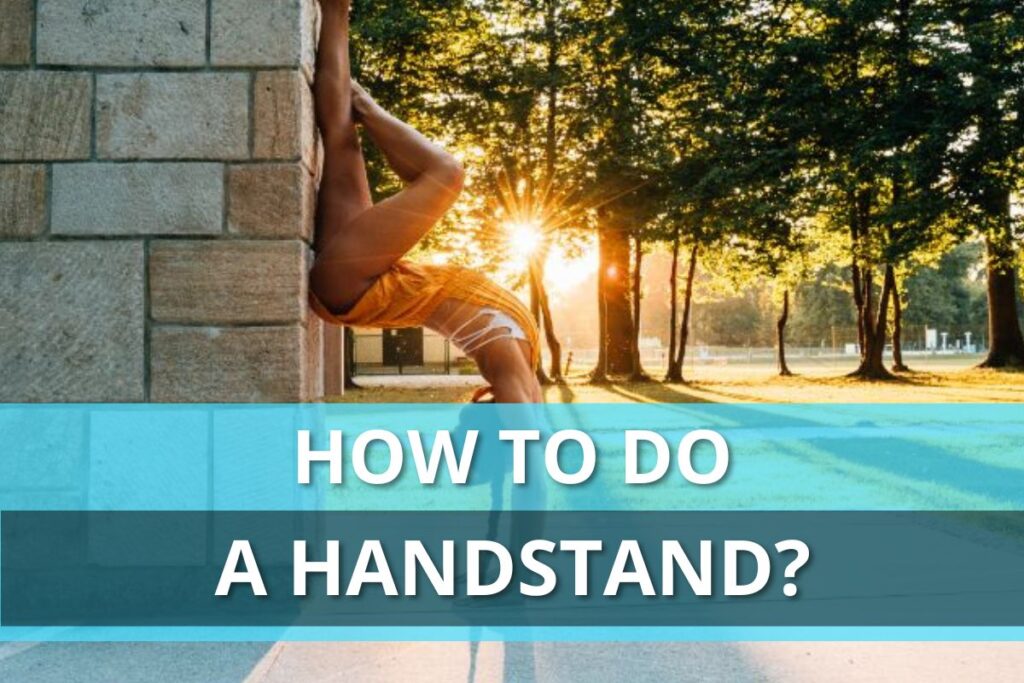
Why Are Handstands Important?
Participating in handstand training has opened my eyes to its profound significance and transformative nature. Besides stunning visuals – performing handstands yields a diverse range of physical and emotional benefits contributing to overall health enhancement.
Physical Benefits
When it comes to getting in shape – it pays to explore different types of workouts – including ones that may seem challenging at first glance. Handstand exercises fall into this category – but don’t let that deter you from trying them out! From boosting core strength to improving alignment – there are many ways that incorporating handstands can enhance your workout routine and contribute to better health outcomes.
1. Delay Signs of Aging
I’ll just start with this one as it is the craziest of the bunch, but also a very true one. A research study done by Frontiers In Medicine in April of 2022 has determined that handstands can promote cerebrovascular elasticity and delay the signs of aging. So even if you disregard every other physical benefit that handstands can do for your body, and take only this one – it’ll be worth both your time and effort!
2. Stronger Core
When attempting a handstand, strong core muscles are absolutely crucial for maintaining both balance and stability throughout the movement. By intentionally utilizing key muscle groups such as the abdominals, obliques, and lower back you’re able to properly position your body. You can do this while simultaneously strengthening this critical area over multiple workouts, which reduces injury risk.
It’s worth noting that developing improved stability extends beyond just performing a proper handstand technique – incorporating specific training strategies will likely enhance overall posture across all areas of physical activity, including sports & workout exercises, with ease whilist preventing potentials accidents or strains in any joints/ligaments/muscles.

3. Upper Body Strength
Handstands are undoubtedly one of the best exercises for strengthening the muscles in your upper body. As you hold yourself upside down with only your arms and shoulders bearing the brunt of the weight-bearing load during this move. It’s’ no surprise that regular practice leads to stronger muscles over time.
As well as sculpting toned arms or chiseling nicely defined abs adopting this position will help improve balance too!
4. Builds Stronger Arms and Wrists
As anyone who has done a handstand knows this move requires a lot from our arms, forearms, and wrists. These muscles are crucial in supporting our weight while keeping us balanced upside down on our hands. Engaging in consistent practice can increase the strength of these muscle groups while also building their ability to endure long periods under pressure.
5. Enhances Shoulder Stability
Proper form while doing a handstand involves having strong & sturdy shoulders. The reason being that controlling balance on hands works out several supporting muscle groups around the shoulder joints, including deltoids, rotator cuffs & scapular stabilizers.
All of which must be strengthened in order for them to function efficiently. Once toned with regular workouts exclusively targeting those areas of the body – you’ll elevate not just stability but also the mobility of your arm regions.
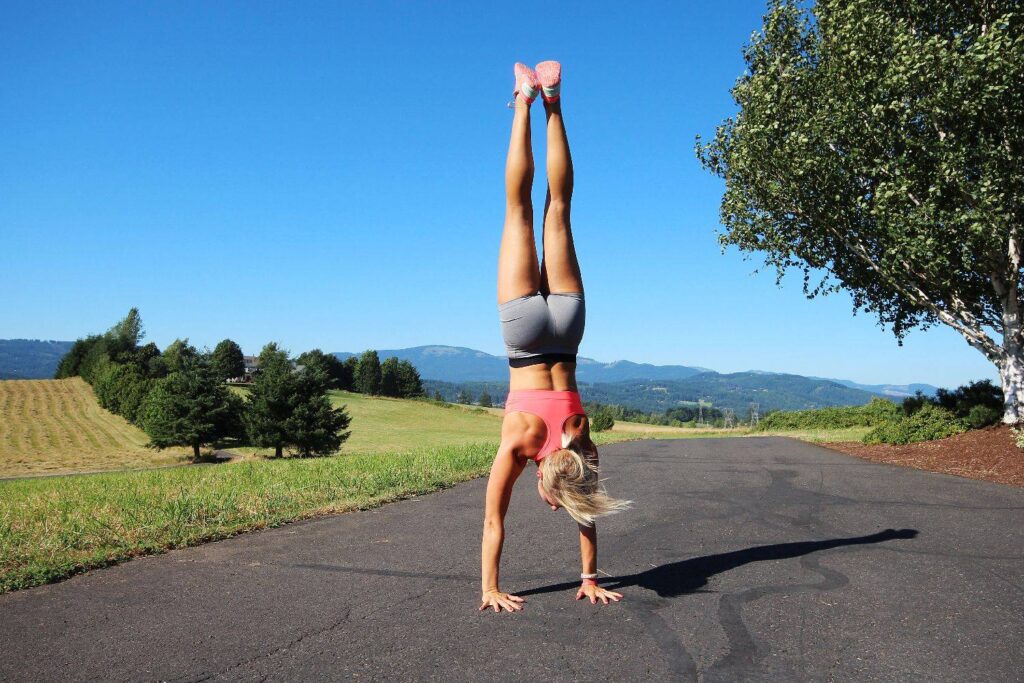
6. Improved Balance and Coordination
For aspiring handstand aficionados seeking improved bodily awareness and kinesthetic mastery, regular practice offers an ideal pathway to progress. By continually refining their ability to sense their own position within space – known technically as proprioception – practitioners can dramatically enhance their handstand skills over time.
But those aren’t the only benefits on offer: such training may also have cross-over effects on overall athleticism, more broadly speaking, fine-tuning motor skills that might support sports or other physical pursuits outside of pure gymnastics contexts.
7. Increased Bone Density
Your body is designed to change over time – but that doesn’t mean you have no control over how it ages! By taking proactive measures like practicing regular handstands as part of your exercise routine, you can support strong bones well into old age. Weight-bearing exercises like handstands provide valuable stress on your bones as they help stimulate fresh growth and promote healthy remodeling processes.
The end result? Increased overall bone density, which helps protect against conditions such as osteoporosis – all while having fun doing something that challenges both body and mind!
8. Boosted Lymphatic System
The use of an inverted position in a handstand has been known to stimulate the lymphatic system and subsequently improve toxin removal while supporting optimized immune function. The ensuing benefits involve bolstered detox processes, lower levels of inflammation and generally enhanced defense against illnesses.
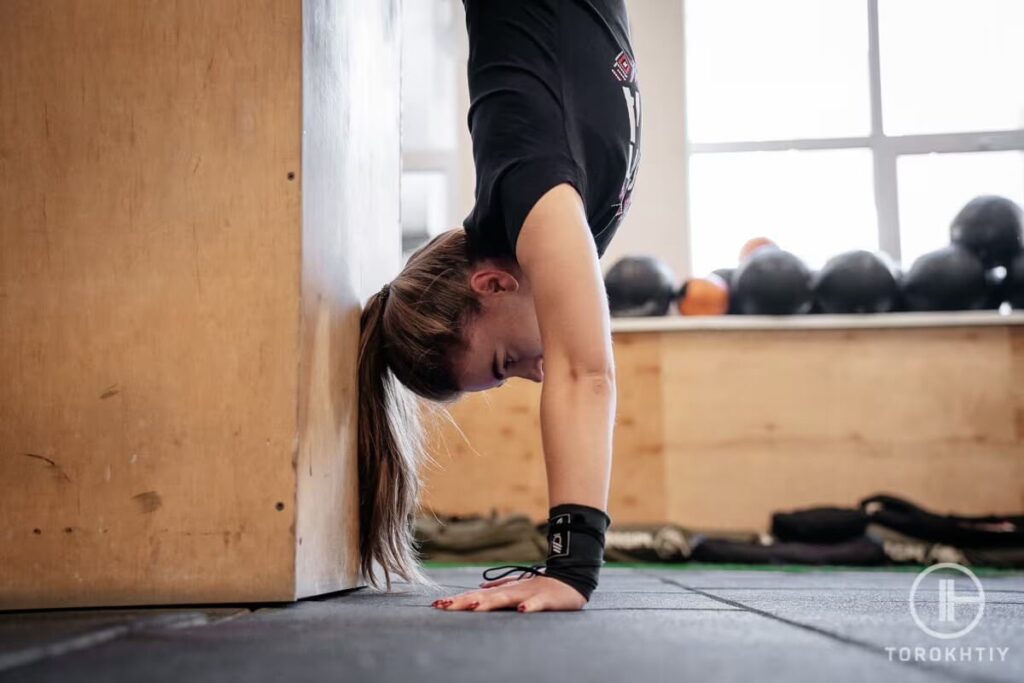
Mental Benefits
There’s no denying the unbelievable benefits that come with attempting a handstand – particularly for one’s physical state. Yet it’s important to acknowledge how this seemingly simple maneuver can also have an equal & noteworthy impact on our mental state.
1. Sharper Focus and Concentration
In order to execute a good handstand you’ll indeed require steel focus and unbreakable concentration. It’s easy to do a handstand when you’re an expert, but performing one when you’re not in your zone of comfort in your ‘safe space’.
But when you’re not an expert, or are doing a handstand variation or perhaps performing in front of a crowd, your mental prowess will become crucial for success. This type of intense concentration has the added benefit of training one’s mind to remain alert and aware of their surroundings constantly and consequently.
2. Enhanced Mind-Body Connection
For those looking to further develop their body awareness skills -practicing handstands can be incredibly beneficial. The exercise emphasizes the mind-body connection. Expanding one’s understanding of bodily requirements while also enhancing overall movement abilities. These practices ultimately foster an intuitive link to your own physical self providing numerous advantages for individuals.
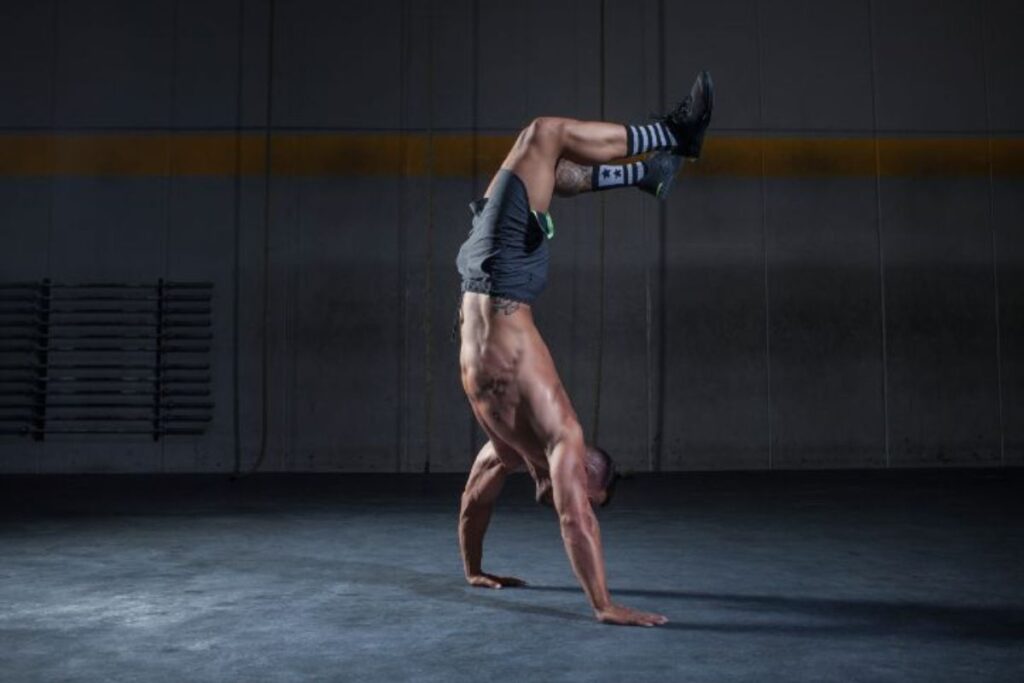
3. Increased Confidence
From mastering intricate techniques to achieving balanced stances from ground zero, the whole process develops tenacity within ourselves, whether we want it or not. This is a great benefit that you’ll get as a side effect of doing handstands without even trying to achieve it – inspiring confidence along with forging productive thought patterns that animate making remarkable strides even off our yoga mats.
4. Stress Relief
Amongst all other practices geared towards calming one’s nervous system down, sustaining an inverted handstand posture is one that stands out as the most effective one. In order for you to be able to sustain a balanced and long handstand, you’ll inevitably get the benefit of stress relief.
The notable benefits obtained include profound relaxation achieved by reducing mental stress with accompanying stillness in the mind. Those dealing with anxious tendencies will find it worthwhile alongside anyone striving for calmness whilst going about daily engagements.
5. Improved Mood
Successfuly executing a handstand feels good. It feels cool! And you don’t have to be an egomaniac or a humble person to experience this feeling. It comes naturally. It can definitely be a dopamine fix that you were looking for in order to boost you up, and also motivate you to do more handstands long-term.
Additionally, by activating endorphin release during physical exertion, our bodies are more proficient at promoting emotional well-being overall.
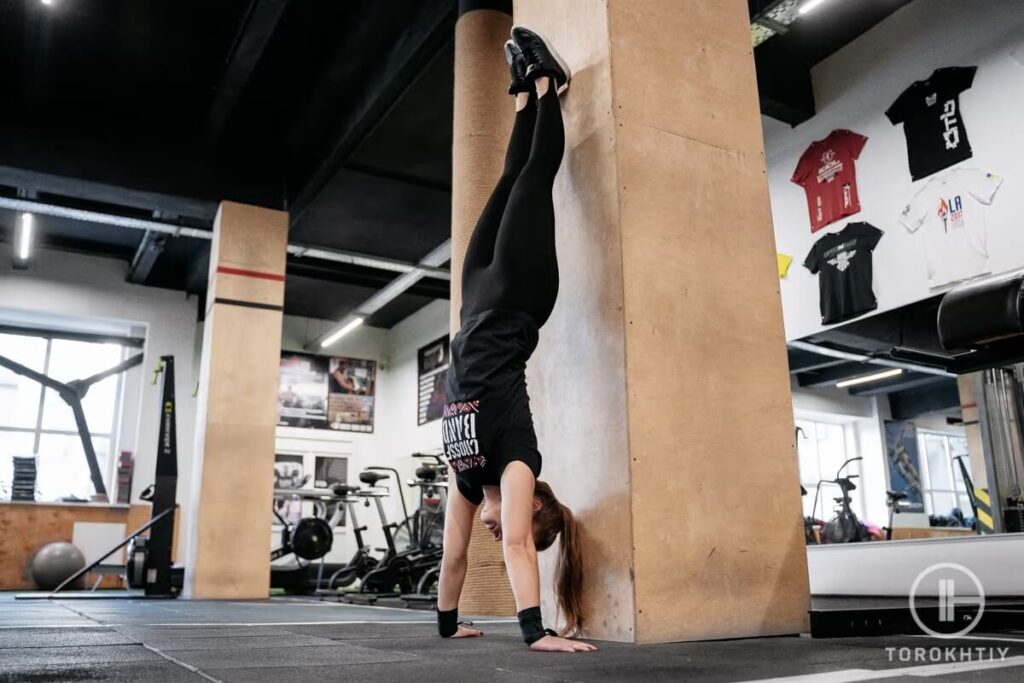
How To Do A Handstand: A 8-Step Guide
If you’re a complete novice when it comes to handstands, you might be unsure as to where to start. Here’s an easy-to-follow guide to go from zero to fully doing a perfect handstand. Of course, it’s not as easy as simply reading the guide. It’ll take some time and dedication, but if you follow each step closely, you’ll surely get there!
1. Warm-Up
Prioritizing injury prevention should be the first step before executing any handstands. Begin with low-impact cardio like jogging or jumping jacks, to increase blood flow throughout your body. After warming up sufficiently, spend some time on exercises that target strengthening of wrist flexors & extensors (palmar & dorsal) along with shoulder & core stabilizers.
2. Get Comfortable with Being Upside Down
You first need to familiarize yourself with being upside-down by trying out a headstand or downward dog posture. This can aid in becoming accustomed to having your heart positioned above your head. Also, keep in mind that it might be confusing, or you might get dizzy at first until you get accustomed enough.
3. Breathing
A common but easily fixable mistake I often see in beginners is that they’d go from being upside down to standing up in a rapid and swift motion. This can result in them getting dizzy. You can easily avoid this by simply inhaling as your head goes up after it is down. Inhale dut=ring the whole head lifting motion, and you’ll avoid any possible dizziness that might otherwise occur.
4. Find a Wall
You can help yourself by leaning against a wall. At least until you get a bit more comfortable. Locate a sturdy wall that can offer assistance during your exercise routine. Keep safety up by choosing an area with sufficient clearance, preventing any accidental injuries if you lose balance. Also, avoid having people around you so that you don’t accidentally kick them while getting down. Experts will like take preemptive precautions on their own.
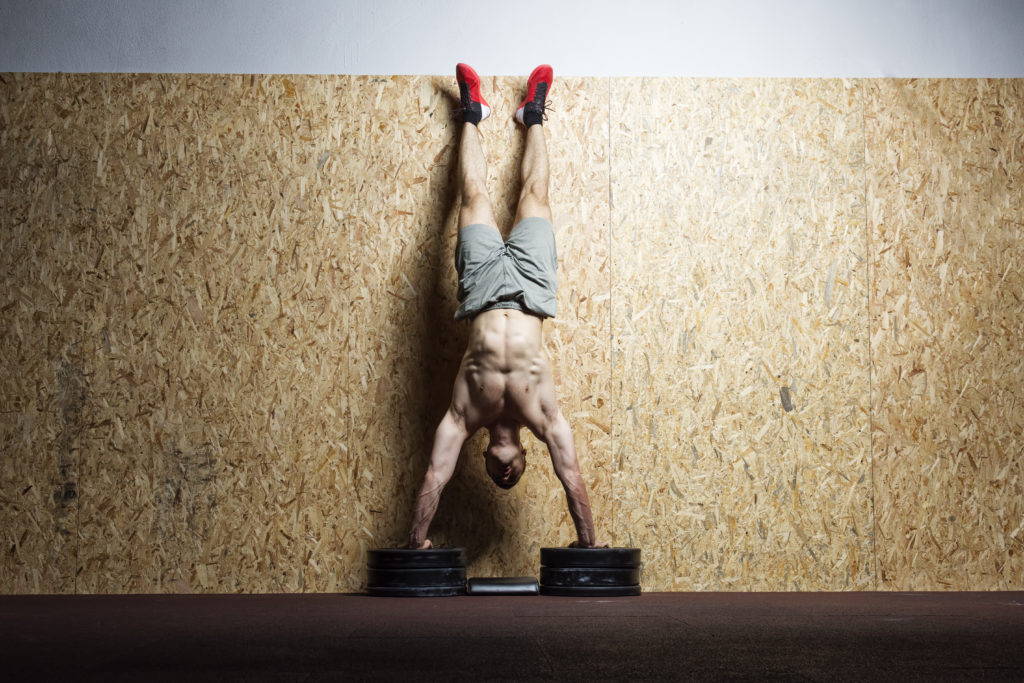
5. Hand Positioning
Securing optimal hand positioning involves setting them firmly at an adequate distance from each other while ensuring that you distribute the weight evenly. A shoulder width spacing should be considered along with maintaining equally spread-out fingers. Allowing you to maintain better control over every movement
6. Kick Up and Balance
Let’s get started by positioning ourselves approximately one leg’s length from the wall. After placing both hands firmly on the ground in front of you, lift one foot off its resting position beside it, followed by another with the help of nearby walls without relenting body posture.
Remember to activate core muscles and do gluteal squeezes during lifting motions while positioning feet with toes facing upward for ideal balance. It is helpful to concentrate on a specific point positioned low near ground level between both palms when wave-riding to enable steadiness.
Follow us!

Free!
Get a 2-week Weightlifting Program as a bonus for the subscription to kickstart your training plan!

Free!
7. Practice
The process of mastering handstands requires dedication and perseverance – it won’t happen overnight. Begin by practicing for shorter intervals and gradually extend the duration as your skill level improves. Remember that with consistent practice comes eventual mastery.
8. Go Wall-Less
Congratulations on mastering the wall-assisted handstand! Now it’s time to challenge yourself by attempting the pose without any support. Remember to take precautions and have a dependable spotter close by for extra assurance. If no spotter is available, then simply take the above steps as a foundation for safety and proceed with small bite-sized steps.
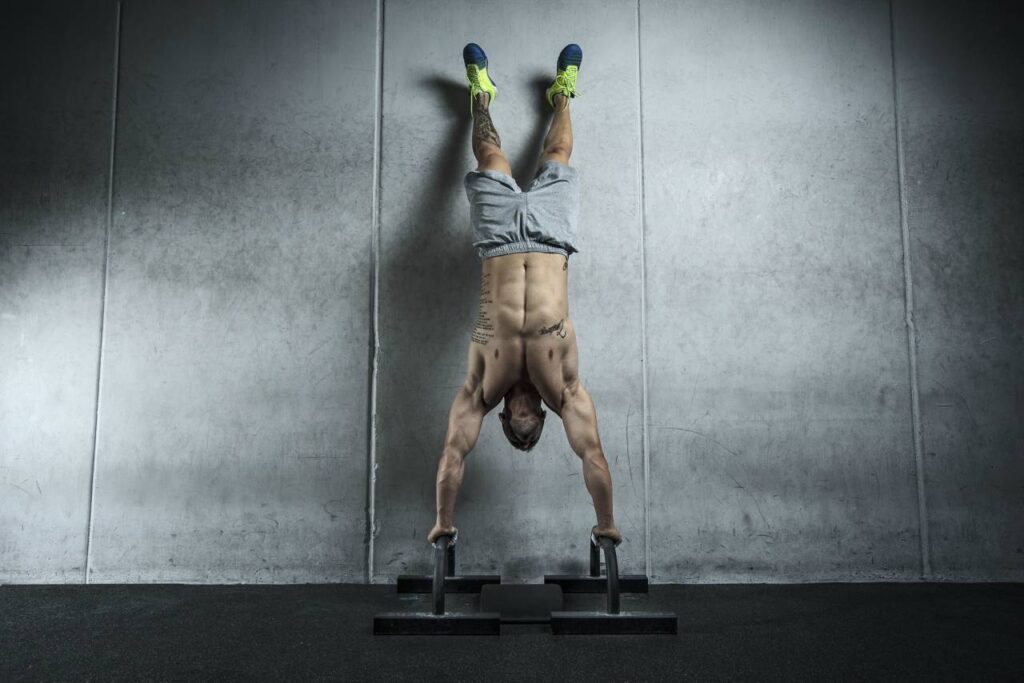
How To Do A Handstand Safe And Fast?
I remember seeing a breakdancer perform a handstand in front of me. And I still recollect that atmosphere. The feelings involved. The excitement. It was surreal. I didn’t think that I’d be able to do it. But just by looking at someone else perform a handstand felt amazing. That initially got me into trying to learn a handstand.
You might have certain reservations and concerns regarding your own safety. Foremost among these concerns was the possibility of breaking my neck! With these worries at play, I remained mindful throughout training and took things at a safe pace as needed.
This, though, didn’t stop me from eventually achieving success while preventing injuries. In case you share similar trepidation regarding undertaking your first handstand experience but nevertheless desire success-consider utilizing some of these handy tips.
The process of learning a handstand isn’t a walk in the park, though. Thus, you might find yourself looking for ways to accelerate that process. Here’s a handstand progression program that might help you learn the handstand more quickly.
1. Build Core Strength
If mastering a fluid handstand stance is something you’re shooting for, it’s impossible not to stress how essential having adequate core strength really is. Without it, your attempts at balancing upside down can quickly go awry. This means focusing heavily on fortifying the muscles that make up our midsection. Incorporating elements like ab workouts and upper torso twists (obliques) into your workout regimen can help ensure this vital region is up to snuff.
Favorites include plank variations, hollow body holds, and also leg lifts. By strengthening these key areas, a more sturdy foundation can be built for the times when you decide to break out your handstand routine- leaving you well-poised for success.
2. Develop Shoulder Stability
Maintaining firm and stable shoulders is necessary for carrying out a handstand without any complications. Adopting exercises like push-ups, shoulder presses and those meant for stability in the area surrounding your shoulders will ensure you have stronger muscles around that region.
And this will in turn reduce the chances of experiencing an injury while performing a handstand. And that is pivotal since, to an athlete, injury is the bane of progress. The strengthened muscles subsequently translate into improved execution techniques when performing future handstands.
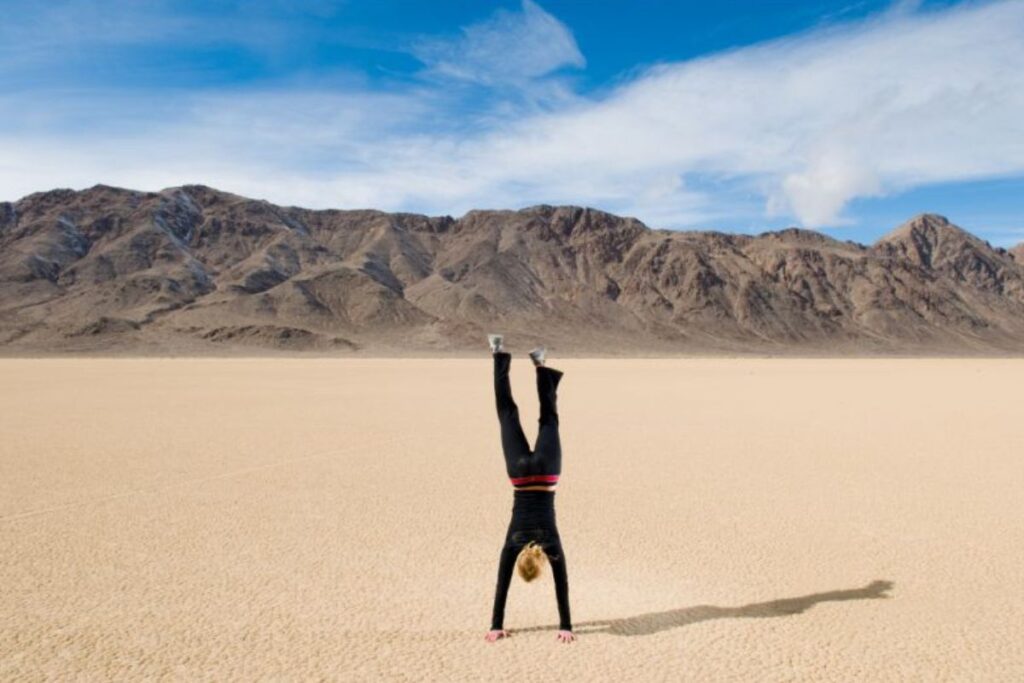
3. Use a Wall for Support
Incorporating a wall into your handstand routine may prove useful in cultivating self-confidence alongside proper posture. To get started, approach with caution by beginning at the beginner level, keeping hands one foot away from the barrier before attempting to kick up slowly. Let heels meet the surface of it, gently-granting yourself added support while paying special attention to maintaining correct alignment throughout.
4. Master the Handstand Alignment
Perfecting a handstand requires paying attention to aligning each aspect of this complex pose properly. Start off strong by focusing on establishing sound foundational practices like placing and spacing out hands at precisely shoulder-width distance, followed by making sure fingers are spread widely for enhancing steadiness through this difficult feat.
Shoulders play an equally vital role- ensure they stack right up above wrists whilst engaging various muscles, including those around scapulae too! The key towards maintaining ideal alignment throughout each stage involves imagining yourself forming one big continuous line from wrists through shoulders leading straight on down- hips, then to legs.
Don’t forget head position, however. Keep your head in a neutral alignment with your spine while also directing your eyesight either between both hands or gazing a little away forward from them.
5. Engage Your Core
Before entering into a handstand position, it’s essential to activate the muscles within your abdominal region by pulling inward on your belly button near to the spinal cord. Engaging these muscles provides support for achieving stable positioning as well as balance while holding this pose.
Throughout this entire movement of hand standing, keep focus on maintaining an overall tightness within this muscle area which creates stable support – necessary for keeping composure and avoiding loss of control while performing this exercise.
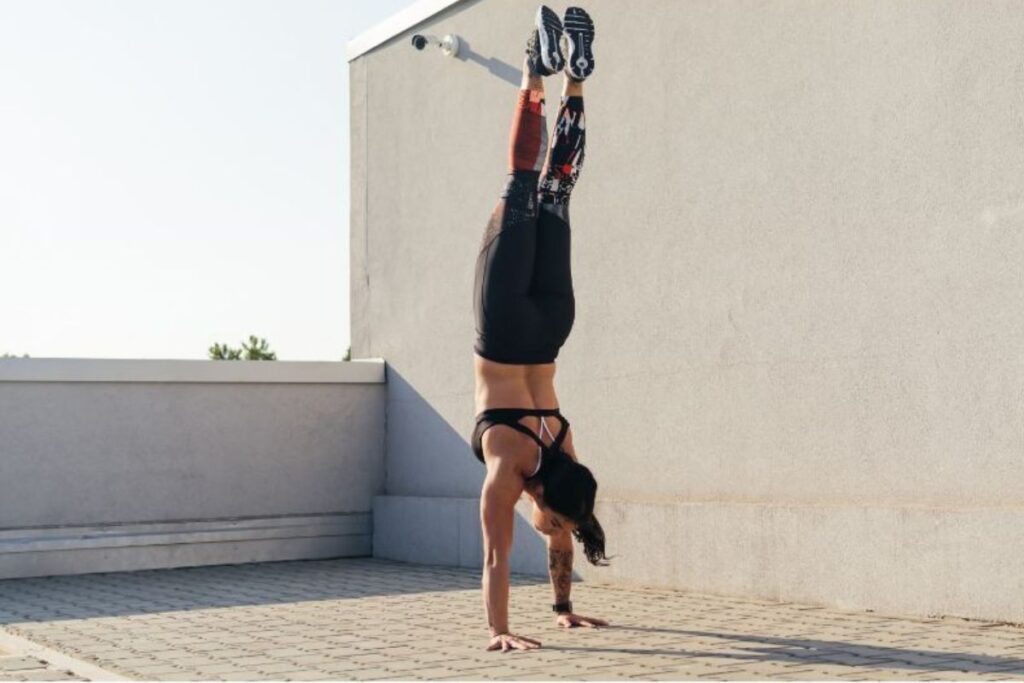
6. Focus on Spotting
Engaging a trained spotter during your exercise regimen offers numerous benefits. They have the ability to coach you on ideal body alignment and technique while providing invaluable support that ensures proper form. Moreover, their presence allows for safer steps when executing challenging moves or postures.
7. Practice Consistently
This can be hard to do if you don’t feel like you’re making much progress but push through that feeling and keep practicing. You don’t need long practice periods; I actually found those somewhat frustrating. Be consistent and practice several times a week in short, focused sessions.
8. Embrace Falling
I know this may sound ridiculous, but before you start practicing, be prepared to fall. A lot. Falling is a natural part of learning handstand and, instead of fearing it, embrace it as an opportunity to learn. For me, learning to fall safely was just another handstand workout and I used to practice by tucking my chin and rolling forward or to the side.
Over time, this helped me to be more comfortable with falling and it boosted my confidence in attempting handstands.
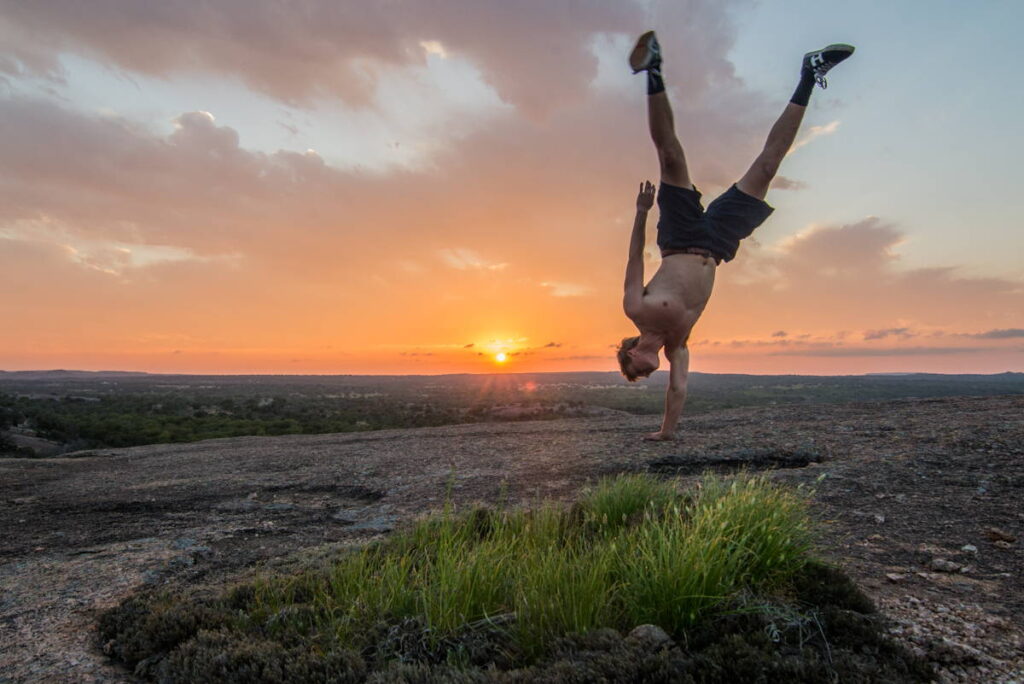
Exercises To Learn A Handstand
How to work up to a handstand? In order to build on the foundation of executing an injury-free and secure handstand. When you train to do a handstand it is important to integrate precise and deliberate movements into your training plan.
By following our recommended set of progressive exercises aimed specifically at refining your technique, you’ll be able to confidently execute a flawless handstand with ease in no time. Rest assured that these routines have helped many individuals master this challenging feat and assert their command over this impressive technique.
1. Wall Walk-Up
Assuming the plank position in front of an immovable wall, carefully climb up it with both feet whilst simultaneously stepping backwards using both palms until achieving full verticality. Practicing this position repeatedly accentuates shoulder robustness and fortifies central body stability by adapting to upside-down arrangements that may be encountered frequently later on.
2. Frog Stand
To commence this exercise begin by placing yourself in a deep squat whilst simultaneously putting each hand firmly upon the floor below you, separated only by shoulder space between them. Once secure, bend forward, aiming to both feet. You’re leaving them hanging above, merely held up by arm power alone.
As you do so, remember to keep defensive alignment, ensuring that both towards engaged core region along with those which control strength across other parts of one’s body play their role correctly. Nevertheless, remain focused throughout the whole routine for optimal results whilst ensuring overall correctness of approach towards execution thereof is maintained throughout exercise functionality itself and accompanying movements associated therewithin.
3. Hollow Body Hold
Begin horizontally positioned on the floor with limbs spread-eagled; palms facing upward towards an overhead view while feet point outward directly ahead of you. Next, elevate three corresponding bodily segments (head, shoulders, legs) away from their flat plane location.
Do this so that you create a faint depression along the body centerline formation regionally closer to midsection anatomy below the ribcage level.
4. Straddle Press
Begin by sitting on the floor with both legs spread out far apart, maintaining them in constant contact with it while shaping them into an even stretch across either side of you. Place each palm beside each hip and exert force onto it, causing yourself to lift upwards from where you sit.
Slowly extend both leg muscles while concurrently elongating each arm until executing a complete mastery over performing idealistic-straddle press handstands at will becomes possible for you!
How To Improve Your Handstands?
Once I’ve mastered doing a handstand on my dominant hand, I’ve got the natural handstand progression into doing it with the non-dominant one. And after a few weeks, it really didn’t feel different whether I’m using my left or right hand.
So, as you do, I started looking for more challenging ways to perform a handstand. And of course, how to do it more efficiently. Was there something I was missing? Perhaps I was doing something wrong, but since I was under the impression that everything was fine – I wouldn’t be able to notice those things.
That brought me to talk to more experienced people. People who’ve been performing handstands, among other things, for years. And Here’s what I’ve learned.
1. Shoulder Mobility
In order to execute a handstand with precision and avoid potential injuries, having appropriate shoulder mobility is imperative. This didn’t really resonate with me at first because I thought I had this under control. But once I saw the more experienced colleagues perform some shoulder mobility exercises and I tried them myself, I quickly came back down to Earth, realizing that there’s still a lot more to do.
So, the first thing, do shoulder mobility. Make sure to incorporate stretching and rotating exercises for your shoulders to enhance their flexibility. This will not only improve your handstand angle and stability, but also help prevent any potential injuries that may occur.
2. Wrist Warm-Up
You’re holding the weight of your whole body on one hand. And all that pressure and the stress is hitting your wrists. To ensure that you’re able to perform handstands without causing unnecessary strain or damage on your wrists, it’s essential to allot ample time for warming up beforehand.
This means carrying out various wrist stretches as well as gentle but effective strengthening exercises that help enhance overall flexibility while reducing any discomfort that may arise.
3. Breath Control
It turns out that control over your breathing is not only for meditation and zen-related things. Handstands require precision in both form and function–and that includes mindful breathing techniques. By focusing on taking deep breaths at an even pace during these movements, we enhance our ability to stay relaxed while maintaining complete concentration.
Developing good breath control ensures increased stability while heightening our body awareness with each attempt.
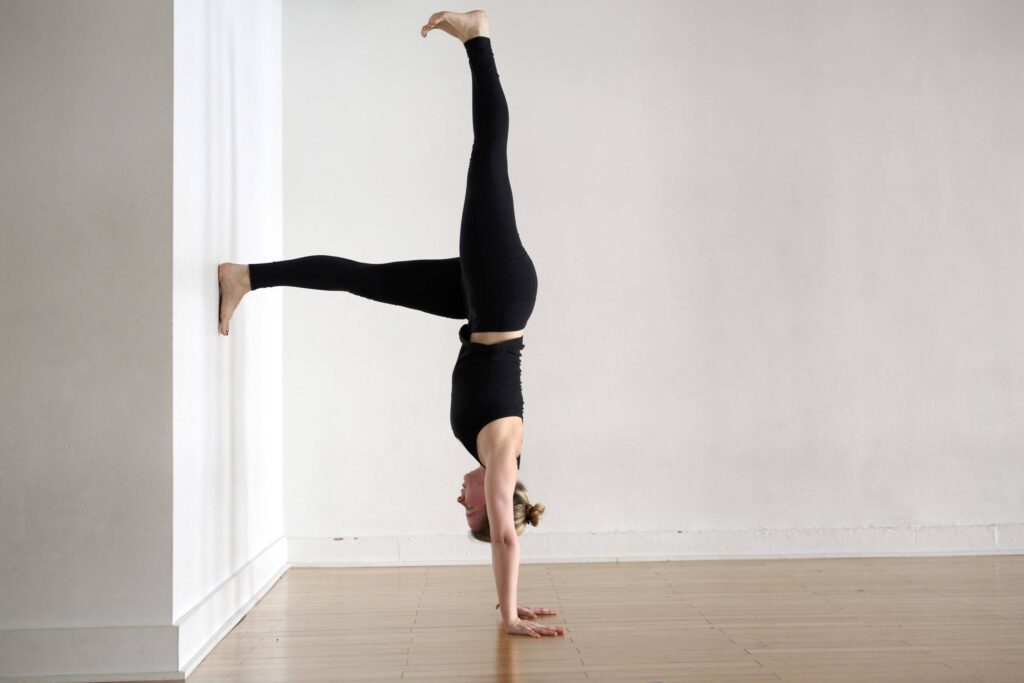
Can Children Do Handstands?
Short answer – Yes, children can do handstands. And yes, it is safe. But, and there is always at least one but – let’s expand upon this short answer, just a little bit.
Children are naturally fascinated by gymnastic moves like handstands. And the curiosity and eagerness to learn are both huge helpers. It’s safe for children to do a handstand as long as certain factors are given due consideration- primarily ensuring they possess enough upper body strength, balance, and body awareness required. As young bodies develop, muscular, joint, and bone strength increases, enabling better control & stability.
Gradual introduction of handstand for beginners and handstand-related exercises with adequate supervision and safety precautions is an excellent starting point. Examples of simple workouts that can boost motor skills levels are bear crawls or crab walks- these activities enhance both balance and upper body strength.
Teaching proper handstand techniques is essential to prevent unnecessary injuries – keeping arms straight maintaining a straight line from wrists to ankles while engaging their core promotes correct body alignment when performing the move. Beginning with supported wall handstands boosts kids’ confidence by creating a sense of balance in a safe environment.

If you’re a complete beginner, I’d suggest you rely on a soft surface. This will help with the stress on your writs (until they strengthen a little bit), and it will help you when falling. And there will be falling.
Also, if it’s available, always opt for training with an experienced hand-stander that will be able to coach and guide you through what you are doing good, what you’re doing bad, and how you can improve your technique. After all, you can’t see yourself doing the handstand (unless you’re using a giant mirror, and even then, it’s not helpful if you don’t know what to look for). An experienced person will.
Can You Do Handstands If You Are New To Gymnastics?
Indeed! Handstand maneuvers are not reserved only for sports enthusiasts but also achievable by anyone applying focused effort towards key areas required within this sport. Overcoming initial intimidating factors begins by breaking down what’s required into smaller segments leading to triumph.
The success of achieving jaw-dropping handstand tricks demands extensive shoulder and core strength, straightforwardly obtained for beginners through bodyweight and resistance training routines that help minimize intrusive injuries by increasing overall control and bodily awareness in balancing weight distribution during activity transitions.
Before every handstand practice, ensure maintaining good posture upright standing beforehand while focusing torso muscles while taking steps forward maintains poise leading to free-form headstand tricks that inspire awe. Soft walls or supporting structures provide adequate beginner support before attempting advanced positions.
No one became “the best” overnight. Keep in mind that progression might come in the form of baby steps. And that is ok. Progression, no matter how slow, will still eventually lead you towards your dream goal.
I urge you to never give up, stay attentive and leverage the experience gained from other, more experienced gymnastics’ successes.
FAQ
Do Handstands Build Muscle?
Yes, they do. For those seeking additional exercises outside conventional weightlifting – handstands show much potential for building musculature, especially in particular areas such as the shoulders, arms, and core. By balancing on two arms extended at full capacity while inverted or holding against a wall -these muscles must work hard enough once engaged long enough, which results in strengthening them over time.
Regular practice sessions dedicated exclusively towards mastering this exercise would undoubtedly enhance overall physique by facilitating both increased strength levels as well as achieving a toned muscular appearance in key targeted areas.
Are Handstands Healthy?
The answer – yes indeed! Handstand exercises are great for strengthening upper body muscles while also enhancing core stabilization skills & balance control too! With regular practice comes enhanced bodily awareness, improved focus levels & boosted confidence within yourself too!
One should, however, always prioritize safety when venturing into high-level workouts like these – adequate warming up followed by gradually progressing towards full mastery is key here- because prevention is better than cure!
How Long Should A Handstand Last?
Between several seconds (for beginners), up to several minutes (if you’re an expert). There’s no exact answer here. The time one can maintain a handstand varies depending on one’s capabilities and strength. While less experienced individuals may begin with short holds of several seconds. They may extend their duration gradually as they gain control and stability.
Conclusion
At first glance executing a perfect handstand might seem impossible or fearful for some people. Nevertheless, when skilled in properly performing them can lead to impressive gains as well-being benefits. It’s achievable and not just limited to some individuals.
Are you an expert when performing them using both left and right hands as well? Also would you care sharing with me when was the point at which you started making progress? I want to hear all those things.
Feel free to use the comments section below to leave any questions, tips, tricks, experiences, and suggestions that you might have. By sharing our knowledge, we can only get better ourselves and help build a slightly more efficient patch for future hand standers!
Also read:
- Side Splits
- How to Do the Splits in 30 Days
- Straddle Split
- Can Anyone Do the Splits
- Stretches for Splits
- Are Handstands Good for You
- How to Do Front Splits
- How to Do a Press Handstand
References:
- Overtraining and Recovery // SpringerLink: https://link.springer.com/article/10.2165/00007256-199826010-00001
- s There a “Window of Opportunity” for Flexibility Development in Youth // NCBI: https://www.ncbi.nlm.nih.gov/pmc/articles/PMC9259532/
- Effectiveness of diaphragmatic breathing for reducing physiological and psychological stress // NCBI: https://pubmed.ncbi.nlm.nih.gov/31436595/
- Isometric Exercise // ScienceDirect: https://www.sciencedirect.com/topics/medicine-and-dentistry/isometric-exercise
- Muscle strain injuries // NCBI: https://pubmed.ncbi.nlm.nih.gov/8947416/
- Why it’s important to cool down after exercise, according to the science // LeveScience: https://www.livescience.com/why-its-important-to-cool-down-after-exercise-according-to-the-science
- Effectiveness of a stretching program on anxiety levels of workers in a logistic platform // NCBI: https://pubmed.ncbi.nlm.nih.gov/23764394/
- Proprioception // ScienceDirect: https://www.sciencedirect.com/topics/neuroscience/proprioception
- Photos by Torokhtiy Media Team; Serhii Yevdokymov, Canva.com; Izf, Canva.com; lagunaguiance, Canva.com; MichaelSvoboda, Canva.com; MerinoPhotos, Canva.com.
Why Trust Us?
With over 20 years in Olympic weightlifting, strength training, nutrition coaching, and general fitness our team does its best to provide the audience with ultimate support and meet the needs and requirements of advanced athletes and professional lifters, as well as people who strive to open new opportunities and develop their physical capabilities with us.
By trusting the recommendations of our certified experts in coaching, nutrition, and sports training programming, as well as scientific consultants, and physiotherapists, we provide you with thorough, well-considered, and scientifically proven content. All the information given in the articles concerning workout programming, separate exercises, and athletic performance, in general, is based on verified data.
The product testing process is described in more detail here.
Author: Oleksiy Kononov
Former Cirque Du Soleil Artist
Ukrainian Gymnast
More than 25 years ago Oleksiy started his sports career. He major in gymnastics which is definitely not an easy sport to go in for!
To become an athletic champion (in Ukraine, for instance, we mean here the title of “Master of Sports”) in gymnastics, one needs to spend at least 10 years and start training no later than being six years old. As for Oleksiy, he has fulfilled all the criteria.
During this period of time, definitely not short, he managed to become:
- Master of Sports, Champion of the State and International Tournaments;
- Member of the national team of Ukraine, having a perfect opportunity to train the best team ever!
- Part of Cirque Du Soleil team (as an artist).
Reviewed by: Oleksiy Torokhtiy
Olympic Weightlifting Champion, PhD in Sport Science
Best Results: Snatch – 200 kg,
C&J – 240 kg
Oleksiy Torokhtiy is a professional athlete boasting 20 years of experience in Olympic weightlifting. With multiple European and World titles under his belt, he has showcased his prowess in two Olympic Games (Beijing 2008 and London 2012). Upon concluding his illustrious career, Oleksiy dedicated himself to coaching. By 2022, he had conducted over 200 weightlifting seminars worldwide. He is the visionary behind an international sportswear and accessories brand known for its motto, “Warm Body Cold Mind.” Additionally, he is an esteemed author and the creator of a series of training programs and eBooks.

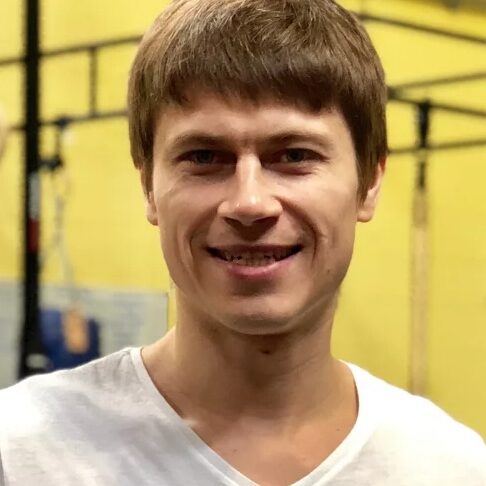



Still have questions after reading our article? Unlock your full potential by engaging with our experts and community! Don’t hesitate — leave a comment below and Oleksiy Kononov will provide a personalized answer and insights to help you reach your goals.